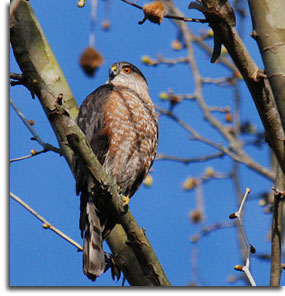Cooper’s Hawk
(Accipiter cooperii)
 Description & Range:
Description & Range:
Cooper's hawk is a medium-sized hawk native to North America named after the naturalist William Cooper, one of the founders of the New York Academy of Sciences. It is also sometimes referred to as the big blue darter, chicken hawk, hen hawk, Mexican hawk, quail hawk, striker and swift hawk.
An adult male weighs a little more than half a pound, is about 15 inches long with a wingspan of 29 inches. As in many birds of prey, the male is smaller than the female. Cooper’s hawks have short rounded wings and a very long tail with dark bands, round-ended at the tip. Adults have red eyes and have a black cap. Their tail is blue gray on top and pale underneath, barred with black bands. They appear long-necked in flight and have been described by birdwatchers as looking like a flying cross.
The Cooper’s hawk breeding range extends from southern Canada to northern Mexico, though some winter as far south as Panama.
Habitat:
They prefer to nest in wooded areas adjacent to wide open fields. In the Chesapeake Bay region, the Cooper's hawk is mostly a bird of forests, streams, and forest edges.
Diet:
The species surprises its prey from cover or while flying quickly through dense vegetation. Most prey are mid-sized birds, like robins, jays or starlings. Cooper’s hawks are often seen hunting in backyards with feeders. They perch in trees overlooking the feeders, then swoop down and scatter the other birds in order to capture one in flight. Dashing through vegetation to catch birds is a rather dangerous lifestyle. A recent study found that 23 percent of all Cooper's hawks examined had healed fractures in the bones of the chest.
Sounds:
Rapid nasal kek, kek, kek
Similar Species:
- Sharp-shinned Hawk
- Northern Goshawk